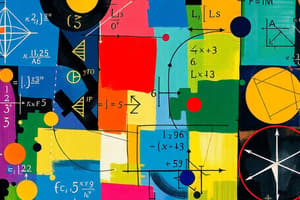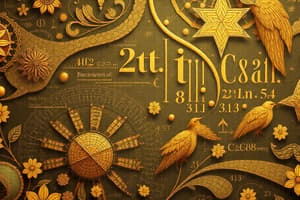Podcast
Questions and Answers
What is the main purpose of graphical representation in mathematics?
What is the main purpose of graphical representation in mathematics?
- To provide theoretical calculations
- To visualize data and mathematical relationships (correct)
- To hide variable relationships
- To complicate data analysis
In which field is mathematics NOT primarily applied for modeling and solving problems?
In which field is mathematics NOT primarily applied for modeling and solving problems?
- Physics
- Cooking (correct)
- Chemistry
- Mechanical Engineering
Which principle highlights the importance of exact calculations in mathematics?
Which principle highlights the importance of exact calculations in mathematics?
- Precision and Accuracy (correct)
- Modeling and Simulation
- Theory and Practice
- Proof and Validation
What is a common application of mathematics in everyday life?
What is a common application of mathematics in everyday life?
Which method is NOT considered a way to prove mathematical statements?
Which method is NOT considered a way to prove mathematical statements?
What is the main focus of Algebra?
What is the main focus of Algebra?
Which theorem is a fundamental part of Geometry?
Which theorem is a fundamental part of Geometry?
What does Calculus primarily study?
What does Calculus primarily study?
Which concept is NOT associated with Statistics?
Which concept is NOT associated with Statistics?
What is a key topic studied in Discrete Mathematics?
What is a key topic studied in Discrete Mathematics?
Which function is a key component of Trigonometry?
Which function is a key component of Trigonometry?
What is the primary concern of Set Theory?
What is the primary concern of Set Theory?
Which branch of mathematics is heavily used in computer science and cryptography?
Which branch of mathematics is heavily used in computer science and cryptography?
Flashcards are hidden until you start studying
Study Notes
Key Branches of Mathematics
-
Arithmetic
- Basics of numbers and operations (addition, subtraction, multiplication, division).
- Concepts of integers, fractions, decimals, and percentages.
-
Algebra
- Handling variables and constants in equations.
- Concepts of expressions, equations, inequalities, and functions.
- Quadratic equations, polynomials, and factoring.
-
Geometry
- Study of shapes, sizes, and properties of space.
- Key concepts include points, lines, angles, surfaces, and solids.
- Theorems like Pythagorean theorem, properties of triangles, circles, and area calculations.
-
Trigonometry
- Relationships between angles and sides of triangles.
- Key functions: sine, cosine, tangent, and their inverses.
- Applications in real-world problems and geometric contexts.
-
Calculus
- Study of change and motion, including derivatives and integrals.
- Fundamental concepts include limits, continuity, and the Fundamental Theorem of Calculus.
- Applications in physics, engineering, and economics.
-
Statistics
- Collection, analysis, interpretation, and presentation of data.
- Concepts include mean, median, mode, variance, and standard deviation.
- Importance of probability and distributions (normal, binomial).
-
Discrete Mathematics
- Study of mathematical structures that are fundamentally discrete (not continuous).
- Includes topics such as graph theory, combinatorics, and algorithm analysis.
- Applications in computer science and cryptography.
Important Mathematical Concepts
-
Set Theory
- Study of sets, subsets, unions, intersections, and Cartesian products.
-
Number Theory
- Properties and relationships of numbers, especially integers.
- Concepts such as prime numbers, divisibility, and modular arithmetic.
-
Mathematical Logic
- Study of formal systems and symbolic reasoning.
- Involves propositions, logical connectives, quantifiers, and inference rules.
-
Vector and Matrix Algebra
- Operations involving vectors and matrices, including addition, multiplication, and inversion.
- Applications in physics, engineering, and computer graphics.
Problem-Solving Techniques
-
Logical Reasoning
- Application of deductive and inductive reasoning to solve problems.
- Understanding patterns and formulating hypotheses.
-
Mathematical Modeling
- Creating abstract representations of real-world phenomena using equations and inequalities.
- Process involves defining variables, establishing relationships, and solving for outcomes.
-
Graphical Representation
- Use of graphs and charts to visualize data and mathematical relationships.
- Includes Cartesian coordinates, function graphs, and statistical plots.
Applications of Mathematics
-
Science and Engineering
- Provides tools for modeling and solving real-world problems.
- Critical in fields like physics, chemistry, and mechanical engineering.
-
Finance and Economics
- Used for modeling economic behavior, optimizing financial portfolios, and risk assessment.
-
Technology
- Essential in computer programming, algorithm development, and data analysis.
-
Everyday Life
- Practical applications in budgeting, cooking, home improvement, and planning.
Key Principles
-
Precision and Accuracy
- Importance of exact calculations and logical reasoning to derive conclusions.
-
Proof and Validation
- Methods of proving mathematical statements (direct proof, proof by contradiction, induction).
-
Theory and Practice
- Balance between understanding theoretical concepts and employing them in practical situations.
Branches of Mathematics
- Arithmetic is the foundation of mathematics, dealing with basic operations on numbers: addition, subtraction, multiplication, and division. It also includes concepts like integers, fractions, decimals, and percentages.
- Algebra introduces the use of variables and constants to represent unknown quantities in equations. Key topics include expressions, equations, inequalities, functions, quadratic equations, polynomials, and factoring.
- Geometry focuses on the study of shapes, sizes, and properties of space. It covers concepts such as points, lines, angles, surfaces, and solids, and includes important theorems like the Pythagorean theorem and properties of triangles, circles, and area calculations.
- Trigonometry explores the relationship between angles and sides of triangles. Key functions include sine, cosine, tangent, and their inverses, with applications in real-world problems and geometric contexts.
- Calculus is the study of change and motion, using derivatives and integrals. Fundamental concepts include limits, continuity, and the Fundamental Theorem of Calculus. Calculus has applications in physics, engineering, and economics.
- Statistics deals with the collection, analysis, interpretation, and presentation of data. Concepts include mean, median, mode, variance, and standard deviation. Probability and distributions, like the normal and binomial distributions, are also significant.
- Discrete Mathematics studies mathematical structures that are fundamentally discrete (not continuous). Topics include graph theory, combinatorics, and algorithm analysis. This field is crucial for computer science and cryptography.
Important Mathematical Concepts
- Set Theory studies sets, subsets, unions, intersections, and Cartesian products.
- Number Theory explores the properties and relationships of numbers, especially integers. Topics include prime numbers, divisibility, and modular arithmetic.
- Mathematical Logic deals with formal systems and symbolic reasoning, encompassing propositions, logical connectives, quantifiers, and inference rules.
- Vector and Matrix Algebra involves operations on vectors and matrices, such as addition, multiplication, and inversion. It has applications in physics, engineering, and computer graphics.
Problem-Solving Techniques
- Logical Reasoning involves applying deductive and inductive reasoning to solve problems. It emphasizes understanding patterns and formulating hypotheses.
- Mathematical Modeling involves creating abstract representations of real-world phenomena using equations and inequalities. This process requires defining variables, establishing relationships, and solving for outcomes.
- Graphical Representation uses graphs and charts to visualize data and mathematical relationships. This includes Cartesian coordinates, function graphs, and statistical plots.
Applications of Mathematics
- Science and Engineering rely heavily on mathematics for modeling and solving real-world problems. It is essential in fields like physics, chemistry, and mechanical engineering.
- Finance and Economics utilize mathematics for modeling economic behavior, optimizing financial portfolios, and risk assessment.
- Technology relies on mathematics for computer programming, algorithm development, and data analysis.
- Everyday Life benefits from mathematics in practical applications like budgeting, cooking, home improvement, and planning.
Key Principles
- Precision and Accuracy are crucial in mathematics. Exact calculations and logical reasoning are vital to derive accurate conclusions.
- Proof and Validation are methods for proving mathematical statements. Common methods include direct proof, proof by contradiction, and induction.
- Theory and Practice should be balanced. Understanding theoretical concepts is essential, but it must be combined with practical applications.
Studying That Suits You
Use AI to generate personalized quizzes and flashcards to suit your learning preferences.




